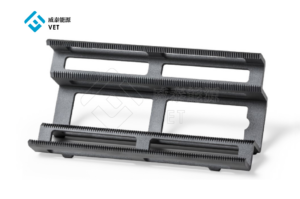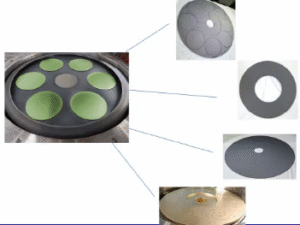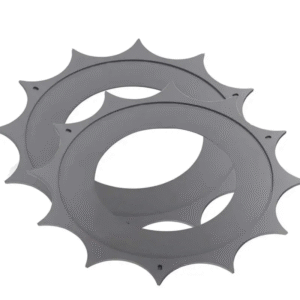Selecting the ideal coating for SiC-based tools requires careful consideration of performance, durability, cost, and compatibility. CVD coatings excel in wear resistance and uniformity, making them suitable for intricate designs. PVD coatings, known for their hardness and affordability, offer a cost-effective alternative. Both options enhance the functionality of SiC coatings in demanding industrial applications.
Key Takeaways
- CVD coatings are great at resisting wear and staying even. They work well for detailed designs and very hot uses.
- PVD coatings are cheaper and still very strong. They resist wear and suit materials that can’t handle much heat.
- Picking CVD or PVD coatings depends on what the job needs. Think about strength, price, and how tricky the use is.
Understanding CVD and PVD Coatings
Overview of CVD Coatings
Chemical Vapor Deposition (CVD) coatings rely on chemical reactions to form a thin, durable layer on a substrate. This process involves introducing reactive gases into a chamber, where high temperatures (600–1000°C or 1112–2012°F) facilitate the deposition of the coating material. The result is a uniform, high-quality layer that bonds chemically with the substrate. CVD coatings are particularly valued for their excellent wear resistance and ability to cover complex geometries with precision. These attributes make them a preferred choice for applications requiring intricate designs and superior durability.
Overview of PVD Coatings
Physical Vapor Deposition (PVD) coatings utilize a different approach, involving the vaporization and condensation of metals onto a substrate. This process occurs in a vacuum environment and employs techniques such as arc ion plating or sputtering. PVD coatings are applied at lower temperatures compared to CVD, making them suitable for heat-sensitive materials. Known for their exceptional hardness and enhanced wear resistance, PVD coatings are widely used in industries where cost-effectiveness and performance are critical. For SiC-based tools, these coatings improve thermal stability and tribological performance, as documented in engineering studies.
Key Differences Between CVD and PVD Coatings
CVD and PVD coatings differ significantly in their mechanisms, temperature requirements, and applications. CVD relies on chemical reactions, while PVD involves physical processes like vaporization. CVD requires higher temperatures, ranging from 600–1000°C, whereas PVD operates at lower temperatures, making it more versatile for various substrates. The table below highlights these distinctions:
| Feature | CVD Coating | PVD Coating |
|---|---|---|
| Process | Utilizes chemical reactions to deposit coatings | Involves vaporization and condensation of metals |
| Temperature Requirements | 600 – 1000°C (1112 – 2012°F) | Lower temperatures, specific to method used |
| Application Methods | Chemical bonding with reactive gases | Arc ion plating and sputtering |
| Vacuum Requirement | Ultrahigh vacuum (~1 Pa) | Ultrahigh vacuum |
| Coating Mechanism | Gaseous state metals react with substrate | Metal ions are directed onto the substrate |
These differences influence the choice of coating based on specific industrial needs. For instance, CVD excels in uniformity and durability, while PVD coatings offer a cost-effective solution with excellent hardness and wear resistance.
Performance of CVD and PVD Coatings on SiC Tools
Adhesion and Wear Resistance
The adhesion strength of a coating determines its ability to remain intact under mechanical stress. CVD coatings exhibit exceptional adhesion due to their chemical bonding with the substrate. This strong bond enhances their durability, making them ideal for applications involving high wear and tear. In contrast, PVD coatings rely on physical deposition, which results in slightly lower adhesion strength. However, their hardness compensates for this limitation, providing excellent wear resistance.
For SiC-based tools, both coating types significantly improve wear resistance. CVD coatings excel in environments with abrasive forces, while PVD coatings perform well in applications requiring a balance between hardness and cost-effectiveness. Industries such as aerospace and automotive manufacturing benefit from these properties, as they demand tools capable of withstanding prolonged use without degradation.
Heat Resistance and Thermal Stability
The ability of a coating to endure high temperatures without losing its properties is critical for SiC tools used in extreme environments. CVD coatings, with their high-temperature deposition process, inherently possess superior thermal stability. They maintain their structural integrity and resist oxidation even in environments exceeding 1000°C.
PVD coatings, although applied at lower temperatures, also offer commendable heat resistance. Their performance depends on the specific materials used in the coating process. For instance, titanium nitride-based PVD coatings enhance thermal stability while maintaining wear resistance.
Thermal analysis studies provide further insight into the heat resistance of these coatings. The table below summarizes key findings:
| Aspect | Description |
|---|---|
| Coating Type | SiC-coated graphite substrates used in MOCVD processes |
| Thermal Stability | SiC coating provides additional thermal stability in high-temperature environments |
| Oxidation Resistance | Protects the graphite substrate from oxidation during high-temperature reactions |
| Applications | Used in semiconductors, optoelectronics, aerospace, automotive manufacturing, and electronics |
| Coating Properties | Enhances hardness, wear resistance, corrosion resistance, and high-temperature performance |
These properties make CVD and PVD coatings indispensable for SiC tools in industries requiring high-temperature operations, such as semiconductor manufacturing and aerospace engineering.
Surface Finish and Coating Uniformity
A smooth surface finish and uniform coating thickness are essential for the optimal performance of SiC tools. CVD coatings excel in this regard, as their chemical deposition process ensures consistent coverage, even on complex geometries. This uniformity reduces surface defects, enhancing the tool’s efficiency and lifespan.
PVD coatings, while slightly less uniform, still provide a high-quality surface finish. Their vacuum-based application minimizes impurities, resulting in a clean and smooth coating. For SiC tools, this translates to improved cutting precision and reduced friction during operation.
The choice between CVD and PVD coatings for surface finish depends on the application’s requirements. CVD coatings are preferred for intricate designs, while PVD coatings offer a cost-effective solution for simpler geometries. Both options contribute to the enhanced performance of SiC-based tools in industrial settings.
Process Conditions for SiC-Based Tools
Temperature and Pressure Requirements
The coating process for SiC-based tools demands precise control of temperature and pressure to ensure optimal results. Chemical Vapor Deposition (CVD) coatings require high temperatures, typically between 900°C and 1000°C, to facilitate chemical bonding. These elevated temperatures enhance coating adhesion and uniformity but may risk substrate deformation if not carefully managed. Physical Vapor Deposition (PVD) coatings, on the other hand, operate at significantly lower temperatures, often below 50°C, making them suitable for heat-sensitive applications.
Pressure conditions also play a critical role. Both CVD and PVD processes rely on ultrahigh vacuum environments to minimize contamination and ensure coating purity. Maintaining a vacuum level of approximately 1 Pa is essential for achieving consistent results. These controlled conditions allow the coatings to integrate seamlessly with SiC substrates, enhancing their performance in demanding industrial applications.
Substrate Preparation for SiC Tools
Proper substrate preparation is vital for achieving high-quality coatings on SiC tools. The preparation process involves several steps to ensure the substrate’s surface is clean, smooth, and free of contaminants:
- Material Composition: The raw SiC material typically contains 4.55 wt.% SiO2, 0.91 wt.% free carbon, 0.36 wt.% iron, and 0.05 wt.% aluminum.
- Heat Treatment: Calcination at 500–800°C and sintering at 900–1650°C in an inert atmosphere improve the material’s stability.
- Crushing and Classification: Techniques like ball milling and air sieving control particle size distribution while minimizing impurities.
The table below highlights the effectiveness of various substrate preparation techniques:
| Technique | Effectiveness Metrics |
|---|---|
| Magnetron Sputtering PVD | Coating temperature < 50°C, enhanced denseness and adhesion, surface roughness polished to 0.8 nm RMS. |
| Chemical Vapor Deposition (CVD) | Requires heating to 1000°C, risk of irreversible deformation, poor denseness and adhesion in some cases. |
| Ion Source-Assisted E-beam Evaporation | High risk of cracking, relatively poor denseness and adhesion. |
These preparation steps ensure the substrate is optimized for coating application, reducing defects and improving overall performance.
Compatibility with SiC Material Properties
The compatibility of coatings with SiC material properties determines their long-term effectiveness. SiC-based composites, such as SiC-Si and SiC/Si3N4, exhibit excellent thermal stability and mechanical strength. Coatings must align with these properties to prevent degradation under operational stress.
Oxidation at the fiber-coating-matrix interface presents a significant challenge. Matrix cracks or exposed fiber ends can allow oxygen to penetrate, leading to oxidation and reduced composite strength. Testing methods, such as ball-on-disk tribo-tests, evaluate wear resistance and adhesion under controlled conditions. For instance:
- Test Parameters: Si3N4 ball (15 GPa hardness), 2 N load, 200 rpm rotation speed, and 10,000 sliding cycles.
- Environmental Conditions: 26°C and 60% relative humidity.
These tests confirm the coatings’ ability to withstand mechanical and environmental stresses, ensuring their compatibility with SiC tools in high-performance applications.
Cost-Effectiveness and Environmental Impact
Cost Comparison of CVD and PVD Coatings
The cost of implementing CVD and PVD coatings varies significantly due to differences in technology and application methods. Industries often face challenges in balancing coating quality with financial constraints.
- Both CVD and PVD technologies involve high capital costs, which can deter widespread adoption.
- While PVD coatings are generally more cost-effective, industries may still opt for less expensive alternatives when budgets are limited.
- The choice between these methods depends on the specific application and the desired performance characteristics.
The table below highlights the cost-effectiveness of various PVD methods across industries:
| PVD Method | Cost-Effectiveness | Applications |
|---|---|---|
| Vacuum Evaporation | High | Electronics, Aerospace |
| Pulsed Laser Deposition | Moderate | Advanced Coatings |
| Sputtering | High | Automotive, Medical Industries |
These insights demonstrate that while PVD coatings offer affordability and versatility, CVD coatings remain a premium choice for applications requiring superior durability and uniformity.
Energy Efficiency and Resource Usage
Energy consumption and resource usage are critical factors in evaluating the efficiency of coating processes. CVD coatings typically require higher energy inputs due to elevated temperatures during deposition. In contrast, PVD coatings operate at lower temperatures, making them more energy-efficient for certain applications.
The table below outlines energy consumption and throughput differences for common coating processes:
| Coating Process | Energy Consumption | Material Fluxes | Throughput Differences |
|---|---|---|---|
| Cathodic Arc Evaporation of TiCN | [Data Not Provided] | [Data Not Provided] | [Data Not Provided] |
| Magnetron Sputter Deposition of TiN | [Data Not Provided] | [Data Not Provided] | [Data Not Provided] |
| CVD of TiCN/Al2O3 Bilayer Coating | [Data Not Provided] | [Data Not Provided] | [Data Not Provided] |
Although specific data is unavailable, PVD coatings are widely recognized for their ability to enhance durability while conserving energy and resources.
Environmental Considerations
Environmental impact assessments (EIAs) highlight the ecological and social effects of coating technologies. These assessments emphasize the importance of interdisciplinary approaches to minimize negative outcomes.
- Coating processes can affect natural resources and ecosystem structures.
- Human health and aesthetic considerations are critical in evaluating environmental impacts.
- Increased air contaminants and water quality degradation are potential risks associated with coating applications.
PVD coatings are often considered more environmentally sustainable due to their lower energy requirements and reduced emissions. However, both CVD and PVD coatings must adhere to strict environmental regulations to mitigate their ecological footprint.
Advantages and Disadvantages of CVD and PVD Coatings
Benefits and Drawbacks of CVD Coatings
Chemical Vapor Deposition (CVD) coatings offer several advantages, particularly in applications requiring high durability and uniformity. The chemical bonding process ensures excellent adhesion, making these coatings highly resistant to wear and tear. Their ability to coat complex geometries with precision makes them ideal for intricate designs, such as those found in semiconductor manufacturing and cutting tools. Additionally, CVD coatings provide superior thermal stability, enabling them to perform well in high-temperature environments.
However, the high deposition temperatures, often exceeding 900°C, can limit their compatibility with heat-sensitive substrates. The process also involves hazardous gases, which require stringent safety measures and environmental controls. Despite these challenges, CVD remains a cost-effective solution for high-volume production, particularly in industries like aerospace and automotive manufacturing.
Benefits and Drawbacks of PVD Coatings
Physical Vapor Deposition (PVD) coatings are known for their versatility and environmental friendliness. These coatings enhance the durability of products, protect against corrosion, and improve the performance of electronic components. Their relatively low deposition temperatures (<500°C) make them suitable for a wide range of substrates, including heat-sensitive materials. PVD coatings also offer aesthetic appeal, with various finishes available for decorative applications.
On the downside, PVD coatings require significant initial investment due to the complexity of the equipment and processes involved. Ongoing operational costs and a potentially longer return on investment period can pose challenges for some industries. Additionally, the coating thickness is typically limited to around 2.5 μm, which may not suffice for certain applications requiring thicker layers. Despite these limitations, PVD coatings remain a preferred choice for industries prioritizing energy efficiency and reduced environmental impact.
Application Suitability for SiC-Based Tools
When to Use CVD Coatings
CVD coatings are ideal for applications requiring exceptional durability, uniformity, and thermal stability. Their chemical bonding process ensures superior adhesion, making them suitable for tools exposed to high wear and tear. Industries that demand intricate designs, such as semiconductor manufacturing, benefit significantly from the precision of CVD coatings. These coatings also excel in high-temperature environments, maintaining their structural integrity and resisting oxidation even under extreme conditions.
For instance, studies on wear-resistant coatings obtained through CVD processes highlight their effectiveness in enhancing the lifespan of SiC-based tools. The ability to coat complex geometries with consistent thickness further underscores their suitability for advanced industrial applications.
When to Use PVD Coatings
PVD coatings are preferred when cost-effectiveness, versatility, and environmental sustainability are critical. Their lower deposition temperatures make them compatible with heat-sensitive substrates, expanding their applicability across various industries. PVD coatings also offer excellent hardness and wear resistance, making them a practical choice for tools requiring enhanced durability without compromising affordability.
In sectors like automotive and electronics, PVD coatings improve the performance of SiC-based tools by providing a protective layer against oxidation and wear. Research comparing the tribological properties of PVD and CVD coatings demonstrates the effectiveness of PVD coatings in applications where a balance between performance and cost is essential.
Industry-Specific Applications
The choice between CVD and PVD coatings depends on the specific requirements of each industry. The table below summarizes the key needs of various sectors and the optimal coating characteristics for SiC-based tools:
| Sector | Key Requirements | Optimal Coating Characteristics |
|---|---|---|
| Aerospace | High-performance materials for extreme conditions | Exceptional thermal stability, wear resistance |
| Automotive | Durability and efficiency for components | Enhanced lifespan, performance in powertrain parts |
| Electronics | Protection against oxidation and wear | High-quality protective coatings for semiconductors |
| Energy | Performance and durability in harsh conditions | Suitable for renewable energy applications |
For aerospace applications, CVD coatings provide the necessary thermal stability and wear resistance to withstand extreme conditions. Automotive manufacturers often rely on PVD coatings to enhance the durability of powertrain components while maintaining cost efficiency. In the electronics sector, both coating types protect semiconductors from oxidation and wear, ensuring reliable performance. The energy industry benefits from coatings that enhance the durability of tools used in renewable energy systems, with both CVD and PVD options offering tailored solutions.
By aligning the coating type with industry-specific demands, manufacturers can optimize the performance and longevity of SiC-based tools, ensuring they meet the rigorous standards of modern industrial applications.
Ningbo VET Energy Technology Co., Ltd: Expertise in Coating Solutions
Overview of Coating Services
Ningbo VET Energy Technology Co., Ltd delivers advanced coating solutions tailored to meet diverse industrial needs. Its state-of-the-art facilities include a Class 1000 dust-free workshop spanning over 3000 square meters. This controlled environment ensures precision and consistency in every coating application. The company collaborates with the Chinese Academy of Sciences to enhance research and development capabilities, enabling specialized production and rigorous testing.
The coating services cater to industries such as aerospace and automotive, where SiC coatings are valued for their high thermal conductivity and resistance. Engineers provide on-site assistance during installation, ensuring seamless integration of coated tools into operational workflows. A 12-month warranty accompanies every delivery, reflecting the company’s commitment to quality and customer satisfaction.
Commitment to Quality and Innovation
Ningbo VET Energy Technology Co., Ltd prioritizes innovation and quality in its coating processes. Its team employs cutting-edge techniques to achieve uniformity and durability in SiC coatings. Regular updates during production keep clients informed, fostering transparency and trust. The company’s quick response times for inquiries demonstrate its dedication to service efficiency.
By leveraging advanced equipment and expertise, Ningbo VET Energy Technology Co., Ltd consistently delivers coatings that meet stringent industry standards. Its focus on continuous improvement ensures that clients receive solutions optimized for performance and reliability.
Supporting SiC-Based Industrial Tool Applications
The company’s coatings enhance the functionality of SiC-based tools across various industries. In aerospace, these coatings improve thermal stability and wear resistance, enabling tools to perform in extreme conditions. Automotive manufacturers benefit from the durability and efficiency of coated components, which extend the lifespan of powertrain parts.
Ningbo VET Energy Technology Co., Ltd’s expertise ensures that SiC coatings align with the specific demands of each sector. Its commitment to precision and innovation positions the company as a trusted partner for industrial applications requiring high-performance tools.
Both CVD and PVD coatings enhance the performance of SiC-based industrial tools, yet their suitability depends on application-specific factors. CVD coatings excel in coating intricate geometries and producing dense, high-purity layers. PVD coatings offer environmentally friendly processes and precise control over coating properties.
| Coating Type | Advantages | Disadvantages |
|---|---|---|
| CVD | – Capable of coating complex geometries | – Higher operational temperatures |
| – Produces dense, high-purity coatings | – Potentially hazardous precursor gases | |
| – Wide range of materials | – More complex equipment and maintenance | |
| PVD | – Environmentally friendly process | – Limitations in coating complex shapes |
| – Precise control over coating properties | – Generally slower deposition rates |
Ningbo VET Energy Technology Co., Ltd leverages advanced technology to deliver tailored coating solutions, ensuring SiC tools meet diverse industrial demands with precision and reliability.
FAQ
What are the main advantages of CVD coatings for SiC-based tools?
CVD coatings provide excellent adhesion, superior wear resistance, and uniform coverage. These qualities make them ideal for intricate designs and high-temperature applications.
How do PVD coatings benefit heat-sensitive SiC tools?
PVD coatings operate at lower temperatures, preserving the integrity of heat-sensitive substrates. They also enhance hardness and wear resistance, ensuring durability in demanding environments.
Which industries commonly use SiC tools with CVD or PVD coatings?
Industries like aerospace, automotive, and electronics rely on these coatings. They improve tool performance in high-temperature, high-wear, and precision-demanding applications.






